Boeing CH-47 Chinook
The Boeing CH-47 Chinook is a tandem-rotor helicopter developed by American rotorcraft company Vertol and manufactured by Boeing Vertol. The Chinook is a heavy-lift helicopter that is among the heaviest lifting Western helicopters. Its name, Chinook, is from the Native American Chinook people of Oregon and Washington state.
| CH-47 Chinook | |
|---|---|
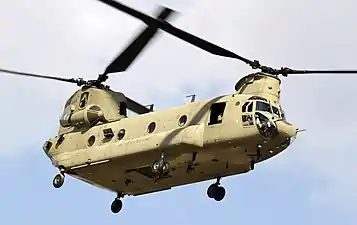 | |
| A U.S. Army CH-47 departs a landing zone in 2014 after unloading soldiers. | |
| Role | Transport helicopter |
| National origin | United States |
| Manufacturer | Boeing Defense, Space & Security |
| First flight | 21 September 1961 |
| Introduction | 1962 |
| Status | In service |
| Primary users | United States Army Japan Ground Self-Defense Force Royal Saudi Air Force See Operators for others |
| Produced | 1962–present |
| Number built | Over 1,200 as of 2012[1] |
| Developed from | Vertol Model 107 |
| Variants | Boeing Chinook (UK variants) |
| Developed into | Boeing Vertol BV-347 |
The Chinook was originally designed by Vertol, which had begun work in 1957 on a new tandem-rotor helicopter, designated as the Vertol Model 107 or V-107. Around the same time, the United States Department of the Army announced its intention to replace the piston-engine–powered Sikorsky CH-37 Mojave with a new, gas-turbine–powered helicopter. During June 1958, the U.S. Army ordered a small number of V-107s from Vertol under the YHC-1A designation; following testing, it came to be considered by some Army officials to be too heavy for the assault missions and too light for transport purposes. While the YHC-1A would be improved and adopted by the U.S. Marine Corps as the CH-46 Sea Knight, the Army sought a heavier transport helicopter, and ordered an enlarged derivative of the V-107 with the Vertol designation Model 114. Initially designated as the YCH-1B, on 21 September 1961, the preproduction rotorcraft performed its maiden flight. In 1962, the HC-1B was redesignated CH-47A under the 1962 United States Tri-Service aircraft designation system.
The Chinook possesses several means of loading various cargoes, including multiple doors across the fuselage, a wide loading ramp located at the rear of the fuselage and a total of three external ventral cargo hooks to carry underslung loads. Capable of a top speed of 170 knots (200 mph; 310 km/h), upon its introduction to service in 1962, the helicopter was considerably faster than contemporary 1960s utility helicopters and attack helicopters, and is still one of the fastest helicopters in the US inventory. Improved and more powerful versions of the Chinook have also been developed since its introduction; one of the most substantial variants to be produced was the CH-47D, which first entered service in 1982; improvements from the CH-47C standard included upgraded engines, composite rotor blades, a redesigned cockpit to reduce workload, improved and redundant electrical systems and avionics, and the adoption of an advanced flight control system. It remains one of the few aircraft to be developed during the early 1960s – along with the fixed-wing Lockheed C-130 Hercules cargo aircraft – that has remained in both production and frontline service for over 60 years.
The military version of the helicopter has been exported to nations across the world; the U.S. Army and the Royal Air Force (see Boeing Chinook (UK variants)) have been its two largest users. The civilian version of the Chinook is the Boeing Vertol 234. It has been used by civil operators not only for passenger and cargo transport, but also for aerial firefighting and to support logging, construction, and oil extraction industries.
Design and development
Background
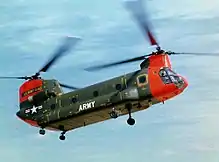
During late 1956, the United States Department of the Army announced its intention to replace the Sikorsky CH-37 Mojave, which was powered by piston engines, with a new, gas turbine-powered helicopter.[2] Turbine engines were also a key design feature of the smaller UH-1 "Huey" utility helicopter. Following a design competition, in September 1958, a joint Army–Air Force source selection board recommended that the Army procure the Vertol-built medium transport helicopter. However, funding for full-scale development was not then available, and the Army vacillated on its design requirements. Some officials in Army Aviation thought that the new helicopter should be operated as a light tactical transport aimed at taking over the missions of the old piston-engined Piasecki H-21 and Sikorsky H-34 helicopters, and be consequently capable of carrying about 15 troops (one squad). Another faction in Army Aviation thought that the new helicopter should be much larger, enabling it to airlift large artillery pieces and possess enough internal space to carry the new MGM-31 "Pershing" missile system.[2]
During 1957, Vertol commenced work upon a new tandem-rotor helicopter, designated as the Vertol Model 107 or V-107.[3][4] During June 1958, the U.S. Army awarded a contract to Vertol for the acquisition of a small number of the rotorcraft, giving it the YHC-1A designation.[5] As ordered, the YHC-1A possessed the capacity to carry a maximum of 20 troops.[2] Three underwent testing by the Army for deriving engineering and operational data. However, the YHC-1A was considered by many figures within the Army users to be too heavy for the assault role, while too light for the more general transport role.[2] Accordingly, a decision was made to procure a heavier transport helicopter, and at the same time, upgrade the UH-1 "Huey" to serve as the needed tactical troop transport. The YHC-1A would be improved and adopted by the Marines as the CH-46 Sea Knight in 1962.[6] As a result, the Army issued a new order to Vertol for an enlarged derivative of the V-107, known by internal company designation as the Model 114, which it gave the designation of HC-1B.[7] On 21 September 1961, the preproduction Boeing Vertol YCH-1B made its initial hovering flight. During 1962, the HC-1B was redesignated the CH-47A under the 1962 United States Tri-Service aircraft designation system; it was also named "Chinook" after the Chinook people of the Pacific Northwest.[8]
The CH-47 is powered by two Lycoming T55 turboshaft engines, mounted on each side of the helicopter's rear pylon and connected to the rotors by drive shafts. Initial models were fitted with engines rated at 2,200 hp (1,600 kW) each. The counter-rotating rotors eliminate the need for an antitorque vertical rotor, allowing all power to be used for lift and thrust. The ability to adjust lift in either rotor makes it less sensitive to changes in the center of gravity, important for the cargo lifting and dropping. While hovering over a specific location, a twin-rotor helicopter has increased stability over a single rotor when weight is added or removed, for example, when troops drop from or begin climbing up ropes to the aircraft, or when other cargo is dropped. If one engine fails, the other can drive both rotors.[9] The "sizing" of the Chinook was directly related to the growth of the Huey and the Army's tacticians' insistence that initial air assaults be built around the squad. The Army pushed for both the Huey and the Chinook, and this focus was responsible for the acceleration of its air mobility effort.[2]
Improved and later versions
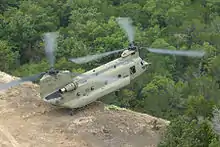
Improved and more powerful versions of the CH-47 have been developed since the helicopter entered service. The U.S. Army's first major design leap was the now-common CH-47D, which entered service in 1982. Improvements from the CH-47C included upgraded engines, composite rotor blades, a redesigned cockpit to reduce pilot workload, improved and redundant electrical systems, an advanced flight control system, and improved avionics.[10] The latest mainstream generation is the CH-47F, which features several major upgrades to reduce maintenance, digitized flight controls, and is powered by two 4,733-horsepower (3,529 kW) Honeywell engines.[11]
A commercial model of the Chinook, the Boeing-Vertol Model 234, is used worldwide for logging, construction, fighting forest fires, and supporting petroleum extraction operations. In December 2006, Columbia Helicopters Inc purchased the type certificate of the Model 234 from Boeing.[12] The Chinook has also been licensed to be built by companies outside the United States, such as Agusta (now AgustaWestland) in Italy and Kawasaki in Japan.[13][14]
Operational history
Vietnam War
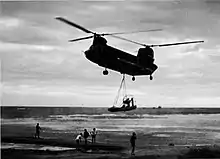
The Army finally settled on the larger Chinook as its standard medium-transport helicopter, and by February 1966, 161 aircraft had been delivered to the Army. The 1st Cavalry Division had brought its organic Chinook battalion (three Chinook companies) when it arrived in 1965 and a separate aviation medium helicopter company, the 147th, had arrived in Vietnam on 29 November 1965.[15] This latter company was initially placed in direct support of the 1st Infantry Division. CH-47 crews quickly learned to mount an M60 machine gun in each of the forward doors. Sometimes they also installed an M2 machine gun to fire from the rear cargo door.[16]
The most spectacular mission in Vietnam for the Chinook was the placing of artillery batteries in perilous mountain positions inaccessible by any other means, and then keeping them resupplied with large quantities of ammunition.[2] The 1st Cavalry Division found that its CH-47s were limited to a 7,000-pound (3,200 kg) payload when operating in the mountains, but could carry an additional 1,000 pounds (450 kg) when operating near the coast.[2] The early Chinook design was limited by its rotor system which did not permit full use of the installed power, and users were anxious for an improved version which would upgrade this system.
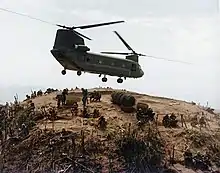
As with any new piece of equipment, the Chinook presented a major problem of "customer education". Commanders and crew chiefs had to be constantly alert that eager soldiers did not overload the temptingly large cargo compartment. It would be some time before troops would be experts at using sling loads.[2] The Chinook soon proved to be such an invaluable aircraft for artillery movement and heavy logistics that it was seldom used as an assault troop carrier. Some of the Chinook fleet was used for casualty evacuation, and due to the very heavy demand for the helicopters, they were usually overburdened with wounded.[17] Perhaps the most cost effective use of the Chinook was the recovery of other downed aircraft.[18]
At the war's peak the US Army had 21 Chinook companies in Vietnam. Pilots discovered the CH-47A's transmission system could not handle the two gas turbines running at full power, and high humidity and heat reduced the maximum lift by more than 20% in the low lands and 30% in mountain areas. More powerful, improved transmission and strengthened fuselages arrived in 1968 with the CH-47B, followed a few months later by the CH-47C. The CH-47s in Vietnam were generally armed with a single 0.308 in (7.62 mm) M60 machine gun on a pintle mount on either side of the aircraft for self-defense, with stops fitted to keep the gunners from firing into the rotor blades. Dust filters were also added to improve engine reliability. Of the nearly 750 Chinook helicopters in the U.S. and South Vietnam fleets, about 200 were lost in combat or wartime operational accidents.[19] The U.S. Army CH-47s supported the 1st Australian Task Force as required.
Four CH-47s were converted into ACH-47As by adding armor and improved engines. Its armament included two fixed forward firing M24A1 20mm cannons, one turret with 40 mm automatic grenade launcher on the nose, five .50 in machine guns and two weapon pods on the sides that could carry either XM159B/XM159C 70 mm rocket launchers or 7.62 mm miniguns. They arrived in Vietnam in 1966, and they engaged in six months of operational testing at An Khê Army Airfield. They performed well in combat, but its high maintenance costs and demand for use in troop and cargo transport was stronger. Three ACH-47s were lost. One collided with a CH-47 while taxiing. Another had a retention pin shake loose on a 20 mm cannon and was brought down when its own gun fired through the forward rotor blades. The third was grounded by enemy fire and destroyed by enemy mortar rounds after the crew escaped.[20]
Iran
During the 1970s, the United States and Iran had a strong relationship, in which the Iranian armed forces began to use many American military aircraft, most notably the F-14 Tomcat, as part of a modernization program.[21] After an agreement signed between Boeing and Agusta, the Imperial Iranian Air Force purchased 20 Agusta-built CH-47Cs in 1971.[22] The Imperial Iranian Army Aviation purchased 70 CH-47Cs from Agusta between 1972 and 1976. In late 1978, Iran placed an order for an additional 50 helicopters with Elicotteri Meridionali, but that order was canceled immediately after the revolution;[23] 11 of them were delivered after multiple requests by Iran.[24]

In the 1978 Iranian Chinook shootdown, four Iranian CH-47Cs penetrated 15–20 km (9.3–12.4 mi) into Soviet airspace in the Turkmenistan Military District. They were intercepted by a MiG-23M which shot down one CH-47, killing eight crew members, and forced a second helicopter to land. Chinook helicopters were used in efforts by the Iranian against Kurdish rebels in 1979.[25]
During the Iran–Iraq War, Iran made heavy use of its US-bought equipment, and lost at least eight CH-47s during the 1980–1988 period, most notably during a clash on 15 July 1983, when an Iraqi Mirage F1 destroyed three Iranian Chinooks transporting troops to the front line, and on 25–26 February 1984, when Iraqi MiG-21 fighters shot down two examples.[26] On 22 March 1982, in Operation Fath ol-Mobin, a key operation of the war, Iranian Chinooks were landed behind Iraqi lines, deployed troops that silenced their artillery, and captured an Iraqi headquarters; the attack took the Iraqi forces by surprise.[27]
Despite the arms embargo in place upon Iran,[28][29] it has managed to keep its Chinook fleet operational.[30][31] Some of the Chinooks have been rebuilt by Panha. As of 2015, 20 to 45 Chinooks were operational in Iran.[32]
Libyan wars
In 1976, the Libyan Air Force purchased 24 Italian-built CH-47C helicopters, 14 of which were transferred to the Libyan Army during the 1990s. The Libyan Air Force recruited Western pilots and technicians to operate the CH-47 fleet.[33] The Libyan Chinooks flew transport and support missions into Chad to supply Libyan ground forces operating there in the 1980s. Chinooks were occasionally used to transport Libyan special forces in assault missions in northern Chad.
In 2002, Libya sold 16 helicopters to the United Arab Emirates, as due to the Western embargo and lack of funds, maintaining them was difficult. The sale to UAE was a $939 million package that included equipment, parts, and training.[34] How many CH-47s are still in existence or operational during the ongoing Libyan civil wars that started in 2011 is not known.
Falklands War
The Chinook was used both by Argentina and the United Kingdom during the Falklands War in 1982.[35]
The Argentine Air Force and the Argentine Army each deployed two CH-47C helicopters, which were widely used in general transport duties. Of the Army's aircraft, one was destroyed on the ground by 30 mm cannon fire from an RAF GR3 Harrier, while the other was captured by the British and reused after the war.[36][37] Both Argentine Air Force helicopters returned to Argentina[38] and remained in service until 2002.
Three British Chinooks were destroyed on 25 May 1982 when Atlantic Conveyor was struck by an Exocet sea-skimming missile fired by an Argentine Super Étendard.[39][40][41] The sole surviving British Chinook, Bravo November, did outstanding service in the Falklands, lifting 81 troops on one occasion and is still in service 38 years later.[42]
Afghanistan and Iraq wars

About 163 CH-47Ds of various operators were deployed to Saudi Arabia, Kuwait, and Iraq during Operation Desert Shield and the subsequent Operation Desert Storm in 1990–91.[43]
The CH-47D has seen wide use in Operation Enduring Freedom in Afghanistan and Operation Iraqi Freedom in Iraq. The Chinook is being used in air assault missions, inserting troops into fire bases, and later bringing food, water, and ammunition. It is also the casualty evacuation aircraft of choice in the British Armed Forces.[44] In combat theaters, it is typically escorted by attack helicopters such as the AH-64 Apache for protection.[45][46] Its lift capacity has been found of particular value in the mountainous terrain of Afghanistan, where high altitudes and temperatures limit the use of helicopters such as the UH-60 Black Hawk; reportedly, one Chinook can replace up to five UH-60s in the air assault transport role.[47]
The Chinook helicopters of several nations have participated in the Afghanistan War, including aircraft from Britain, Italy, the Netherlands, Spain, Canada, and Australia. Despite the age of the Chinook, it is still in heavy demand, in part due its proven versatility and ability to operate in demanding environments such as Afghanistan.[11][48]
In May 2011, an Australian Army CH-47D crashed during a resupply mission in Zabul Province, resulting in one fatality and five survivors. The helicopter was unable to be recovered and was destroyed in place.[49][50] To compensate for the loss, the ADF added two ex-U.S. Army CH-47Ds to the fleet which are expected to be in service until the introduction of the CH-47Fs in 2016.[51]
On 6 August 2011, a Chinook crashed near Kabul, killing all of the 38 aboard. The Chinook was reportedly shot down with a rocket-propelled grenade by the Taliban while attempting to assist a group of U.S. Navy SEALs. The 38 were members of NATO and allied forces, including 22 Naval Special Warfare operators, five U.S. Army Aviation soldiers, three U.S. Air Force special operations personnel, and seven Afghan National Army commandos. A civilian translator and a U.S. military working dog were also killed in the crash. The crash was the single deadliest during the entire Operation Enduring Freedom campaign. The previous biggest single-day loss for American forces in Afghanistan involved a Chinook that was shot down near Kabul in Kunar Province in June 2005 with all aboard killed, including a 16-member U.S. Special Operations team.[52][53]
Disaster relief
According to Suresh Abraham, the Chinook's ability to carry large, underslung loads has been of significant value in relief operations in the aftermath of natural disasters.[54] Numerous operators have chosen to deploy their Chinook fleets to support humanitarian efforts in stricken nations overseas. Following the 2004 Asian tsunami, the Republic of Singapore Air Force assisted in the relief operations in neighboring Indonesia using its Chinooks; similarly, after the 2005 Kashmir earthquake, the Royal Air Force dispatched several Chinooks to Northern Pakistan to assist in recovery efforts.[54]
In August 1992, six CH-47Ds were deployed from Fort Bragg in North Carolina to provide relief in the wake of Hurricane Andrew in what was one of the first major helicopter disaster relief operations on US soil.[55] Then President George H. W. Bush ordered the military to assist. The Chinooks arrived at Miami-Opa Locka Executive Airport, just outside of the disaster zone, one day after the President's order; early on, they performed a wide loop over Homestead and Florida City to publicly display their presence, helping to curtail lawlessness and looting.[56][57] The Chinooks initially flew twelve sorties per day out of Opa Locka, which expanded over time, often supporting distribution operations at Homestead AFB and Opa Locka, as well as delivering relief payloads via internal storage, not using sling loads, supplementing the two dozen distribution centers and trucks, proving essential as trucks could not reach the worst hit areas due to downed trees and power lines. They flew everyday for approximately three weeks, moving supplies and personnel around the disaster zone as well as carrying media and government officials, including then Congressman Bill Nelson. Ultimately, the Chinooks supplied 64 distribution sites throughout the zone and transported 1.2 million pounds of supplies before the urgent relief phase ended.[56]
Three of Japan's CH-47s were used to cool Reactors 3 and 4 of the Fukushima Nuclear power plant following the 9.0 earthquake in 2011; they were used to collect sea water from the nearby ocean and drop it over the affected areas.[58][59] In order to protect the crew from the heightened radiation levels present, a number of lead plates were attached to the floor of each Chinook;[60][61] even with such measures, pilots had to keep their distance from the reactors while also limiting flight times in the vicinity to a maximum of 45 minutes to avoid excessive radiation exposure.[62]
Other roles
.jpg.webp)
Since the type's inception, the Chinook has carried out various secondary missions, including medical evacuation, disaster relief, search and rescue, aircraft recovery, fire fighting, and heavy construction assistance.[63]
In February 2007, the Royal Netherlands Air Force became the first international customer of the CH-47F model, expanding their Chinook fleet to 17.[64] On 10 August 2009, Canada signed a contract for 15 extensively modified and upgraded CH-47Fs for the Canadian Forces, later delivered in 2013–2014 with the Canadian designation CH-147F.[11][65] On 15 December 2009, Britain announced its Future Helicopter Strategy, including the purchase of 24 new CH-47Fs to be delivered from 2012.[66] Australia ordered seven CH-47Fs in March 2010 to replace its six CH-47Ds between 2014 and 2017.[67][68] In September 2015, India approved purchase of 15 CH-47F Chinooks.[69] On 7 November 2016, Singapore announced that the CH-47F would replace its older Chinooks, which had been in service since 1994, enabling the Republic of Singapore Air Force to meet its requirements for various operations, including Search and Rescue (SAR), Aeromedical Evacuation (AME), and Humanitarian Assistance and Disaster Relief (HADR) operations.[70]
In February 2020, the Indian Air Force started using Chinooks at theatres such as Ladakh and Siachen Glacier to assist Indian forces deployed at the Indian borders with China and Pakistan.[71]
Variants
.jpg.webp)
HC-1B
The pre-1962 designation for Model 114 development aircraft that would be redesignated CH-47 Chinook.[72]
CH-47A
The all-weather, medium-lift CH-47A Chinook was powered initially by Lycoming T55-L-5 engines rated at 2,200 horsepower (1,640 kW), which were replaced by the T55-L-7 rated at 2,650 hp (1,980 kW) engines or T55-L-7C engines rated at 2,850 hp (2,130 kW). The CH-47A had a maximum gross weight of 33,000 lb (15,000 kg), with a maximum payload about 10,000 lb (4,500 kg)[73] Delivery of the CH-47A Chinook to the U.S. Army began in August 1962. A total of 354 were built.[74]
ACH-47A
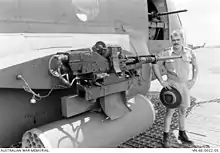
The ACH-47A was known as the Armed/Armored CH-47A (or A/ACH-47A) before being designated ACH-47A[75] as a U.S. Army Attack Cargo Helicopter, and unofficially referred to as Guns A Go-Go. Four CH-47A helicopters were converted to gunships by Boeing Vertol in late 1965. Three were assigned to the 53rd Aviation Detachment in South Vietnam for testing, with the remaining one retained in the U.S. for weapons testing. By 1966, the 53rd was redesignated the 1st Aviation Detachment (Provisional) and attached to the 228th Assault Support Helicopter Battalion of the 1st Cavalry Division (Airmobile). By 1968, only one gunship remained, and transport demands prevented more conversions. It was returned to the United States, and the program stopped.[76]
The ACH-47A carried five 7.62 × 51 mm M60D machine guns or .50-caliber (12.7 mm) M2HB heavy machine guns, provided by the XM32 and XM33 armament subsystems, two 20 mm M24A1 cannons, two 19-tube 2.75-inch (70 mm) Folding Fin Aerial Rocket launchers (XM159B/XM159) or sometimes two M18/M18A1 7.62 × 51 mm gun pods, and a single 40 mm M75 grenade launcher in the XM5/M5 armament subsystem (more commonly seen on the UH-1 series of helicopters). Rare newsreel footage shows one of the aircraft in action supporting the 8th Cavalry Regiment during an ambush at Bông Son, South Vietnam.[77] The surviving aircraft, Easy Money, has been restored and is on display at Redstone Arsenal, Alabama.[78][79]
CH-47B
The CH-47B was an interim upgrade while Boeing worked on a more substantially improved CH-47C. The CH-47B was powered by two Lycoming T55-L-7C 2,850 hp (2,130 kW) engines. It had a blunted rear rotor pylon, redesigned asymmetrical rotor blades, and strakes along the rear ramp and fuselage to improve flying characteristics. It could be equipped with two door-mounted M60D 7.62 mm NATO machine guns on the M24 armament subsystem and a ramp-mounted M60D using the M41 armament subsystem. Some CH-47 "bombers" were equipped to drop tear gas or napalm from the rear cargo ramp onto Viet Cong bunkers. The CH-47B could be equipped with a hoist and cargo hook. The Chinook proved especially valuable in "Pipe Smoke" aircraft recovery missions. The "Hook" recovered about 12,000 aircraft valued at over $3.6 billion during the war; 108 were built.
CH-47C
_CH-47C_Chinook_(219)_Bidini-1.jpg.webp)
The CH-47C featured more powerful engines and transmissions.[80] Three sub-versions were built, the first with Lycoming T55-L-7C engines delivering 2,850 shp (2,130 kW). The "Super C" had Lycoming T55-L-11 engines delivering 3,750 shp (2,800 kW), an upgraded maximum gross weight of 46,000 lb (21,000 kg), and pitch stability augmentation. The T55-L-11 engines were less reliable, as they had been hurriedly introduced to increase payload; thus, they were temporarily replaced by the more reliable Lycoming T55-L-7C. The Super C was distinguishable from the standard "C" by the uprated maximum gross weight.
The type was not approved by the FAA for civil aviation due to the nonredundant hydraulic flight boost system drive. The hydraulic system was redesigned for the succeeding CH-47D, allowing it to achieve certification as the Boeing Model 234. A total of 233 CH-47Cs were built. Canada bought eight CH-47Cs; deliveries of the type began in 1974. Receiving the Canadian designation "CH-147", these were fitted with a power hoist above the crew door; other changes included a flight engineer station in the rear cabin: operators referred to the configuration as the "Super C".[81] The CH-47C was used widely during the Vietnam War, eventually replacing the older Piasecki H-21 Shawnee in the combat assault support role.
CH-47D
.jpg.webp)
The CH-47D shares the same airframe as earlier models, with more powerful engines. Early CH-47Ds were powered by two T55-L-712 engines. The most common engine is the later T55-GA-714A. With its triple-hook cargo system, the CH-47D can carry heavy payloads internally and up to 26,000 lb (12,000 kg) (such as 40-foot or 12-metre containers) externally. It was introduced into service in 1979. In air assault operations, it often serves as the principal mover of the 155 mm M198 howitzer, plus 30 rounds of ammunition, and an 11-man crew. The CH-47D has advanced avionics, including Global Positioning System. Nearly all US Army CH-47Ds were converted from previous A, B, and C models, a total of 472 being converted. The last U.S. Army CH-47D built was delivered to the U.S. Army Reserve, located at Fort Hood, Texas, in 2002.[82]
The Netherlands acquired all seven of the Canadian Forces' surviving CH-147Cs and upgraded them to CH-47D. Six more new CH-47Ds were delivered in 1995 for a total of 13. The Dutch CH-47Ds are improved over U.S. Army CH-47Ds, including a long nose for Bendix weather radar, a "glass cockpit", and improved T55-L-714 engines. As of 2011, the Netherlands planned upgrading 11 of them to the CH-47F standard at a later date.[83] As of 2011, Singapore has 18 CH-47D/SDs, which includes twelve "Super D" Chinooks, in service.[84] In 2008, Canada purchased 6 CH-47Ds from the U.S. for the Canadian Helicopter Force Afghanistan for $252 million.[85][86] With 1 CH-47D lost to an accident,[87] the remaining five were sold in 2011 after the end of Canada's Afghanistan mission and replaced with seven CH-147Fs.[88]
MH-47D
The MH-47D was developed for special forces operations and has inflight refueling capability, a fast rope-rappelling system, and other upgrades. The MH-47D was used by U.S. Army 160th Special Operations Aviation Regiment. Twelve MH-47D helicopters were produced. Six were converted from CH-47As and six were converted from CH-47C models.[89]
MH-47E

The MH-47E has been used by U.S. Army Special Operations. Beginning with the E-model prototype manufactured in 1991, a total of 26 Special Operations Aircraft were produced. All aircraft were assigned to 2–160th SOAR(A) "Nightstalkers", home based at Fort Campbell, Kentucky. E models were converted from CH-47C airframes. The MH-47E has similar capabilities as the MH-47D, but with increased fuel capacity similar to the CH-47SD and terrain following/terrain avoidance radar.[90]
In 1995, the Royal Air Force ordered eight Chinook HC3s, effectively a lower cost MH-47E for special operations. They were delivered in 2001, but never became operational due to technical issues with their avionics fit, unique to the HC3. In 2008, work started to revert the HC3s to HC2 standard, to enable them to enter service.[91] As of 2017 they were upgraded to HC5 standard with a digital automated flight control system.[92]
CH-47F
.jpg.webp)
In 2001, the CH-47F, an upgraded CH-47D, made its maiden flight. The first production model rolled out at Boeing's facility in Ridley Park, Pennsylvania, and first flew on 23 October 2006.[93] Upgrades included 4,868-shaft-horsepower (3,630 kW) Honeywell engines and airframe with better integrated construction for lower maintenance requirements.[94] The milled construction reduces vibration, as well as inspection and repair needs, and eliminates flexing points to increase service life.[95] The CH-47F can fly at speeds of over 175 mph (282 km/h) with a payload of more than 21,000 lb (9,500 kg).[96] New avionics include a Rockwell Collins Common Avionics Architecture System (CAAS) cockpit, and BAE Systems' Digital Advanced Flight Control System (DAFCS).[94] AgustaWestland assembles the CH-47F under license, known as the Chinook ICH-47F, for several customers.[97] Boeing delivered 48 CH-47Fs to the U.S. Army through August 2008; at that time Boeing announced a $4.8 billion (~$6.02 billion in 2021) contract with the Army for 191 Chinooks.[96]
A CH-47F Block 2 is being implemented as of 2020. The Block 2 aims for a payload of 22,000 lb (10,000 kg) with 4,000 ft (1,200 m) and 95 °F (35 °C) high and hot hover performance, eventually increased up to 6,000 ft (1,800 m), to carry the Joint Light Tactical Vehicle; maximum takeoff weight would be raised to 54,000 lb (24,500 kg). A composite-based Advanced Chinook Rotor Blade (derived from the cancelled RAH-66 Comanche) was originally planned, along with 20% more powerful Honeywell T55-715 engines, and the active parallel actuator system (APAS) which enhances the digital advanced flight-control system, providing an exact torque split between the rotors for greater efficiency. A new fuel system combines the three fuel cells in each sponson into one larger fuel cell and eliminates intracell fuel transfer hardware, reducing weight by 90 kg (200 lb) and increasing fuel capacity. Electrical capacity is increased by three 60 kVA generators.[98][99] The Advanced Chinook Rotor Blades (ACRB), were intended to improve lift performance in hot/high altitude conditions by 2,000 lb. After trials in 2020, ACRB testing was postponed by the US Army due to vibration issues. Boeing denied the Army's assertion that the vibration issues were a safety risk and believed it could be solved with dampeners. Testing resumed in 2021 but the Army ultimately decided against implementing the ACRB when vibration persisted in the resumed testing. In addition the aft rotor blade was stalling when in a swept back position.[100]
The U.S. Army plans for a Block 3 upgrade after 2025, which could include a new 6,000 hp (4,500 kW) class engine with boosted power capacity of the transmission and drive train developed under the future affordable turbine engine (FATE) program and a lengthened fuselage. The Future Vertical Lift program plans to begin replacing the Army's rotorcraft fleet in the mid-2030s, initially focusing on medium-lift helicopters, thus the CH-47 is planned to be in service beyond 2060, over 100 years after first entering service.[99]
The German government announced in June 2022 that the CH-47F Block 2 was selected as the winner of its heavy helicopter program to replace its Sikorsky CH-53G Sea Stallion fleet.[101][102]
MH-47G
The MH-47G Special Operations Aviation (SOA) version is similar to the MH-47E, but features more sophisticated avionics including a digital Common Avionics Architecture System (CAAS). The CAAS is a common glass cockpit used by helicopters such as MH-60K/Ls, CH-53E/Ks, and ARH-70As.[103] The MH-47G also incorporates all of the new sections of the CH-47F.[104]
The modernization program improves MH-47D and MH-47E Special Operations Chinooks to the MH-47G design specs. A total of 25 MH-47E and 11 MH-47D aircraft were upgraded by the end of 2003. In 2002, the army announced plans to expand the Special Operations Aviation Regiment via an additional 12 MH-47G helicopters. The final MH-47G Chinook was delivered to the U.S. Army Special Operations Command on 10 February 2011. Modernization of MH-47D/E Chinooks to MH-47G standard is due by 2015.[105]
On 1 September 2020, Boeing announced that their Philadelphia plant had delivered the first MH-47G Block II helicopter to U.S. Army Special Operations Command (USASOC), saying that the delivery was made "recently", and was "on time". This was the first MH-47G Block II of the initial order of 24, with a stated ultimate requirement for 69. The MH-47G Block II includes all of the improvements from the CH-47F Block II, as well as inflight refueling capability, a comprehensive defensive aids suite and low-level/adverse weather piloting aids, such as forward-looking infrared and multi-mode/terrain-following radar. It is armed with two 7.62 mm M134 Miniguns and two M240 7.62 mm machine guns.[106]
The British MOD confirmed that while the U.S. does not export the model, the two countries were in discussion regarding the MH-47G as of 2017.[107] On 19 October 2018, the Defense Security Cooperation Agency notified Congress of a possible sale of 16 H-47 Chinooks (Extended Range) to the UK.[108]
CH-47J
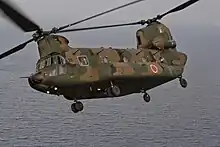
The CH-47J is a medium-transport helicopter for the Japan Ground Self-Defense Force (JGSDF), and the Japan Air Self-Defense Force (JASDF).[109] The differences between the CH-47J and the CH-47D are the engine, rotor brake and avionics, for use for general transportation, SAR and disaster activity like U.S. forces.[110] The CH-47JA, introduced in 1993, is a long-range version of the CH-47J, fitted with an enlarged fuel tank, an AAQ-16 FLIR in a turret under the nose, and a partial glass cockpit.[110][111] Both versions are built under license in Japan by Kawasaki Heavy Industries, who produced 61 aircraft by April 2001.[112]
The Japan Defense Agency ordered 54 aircraft of which 39 were for the JGSDF and 15 were for the JASDF. Boeing supplied flyable aircraft, to which Kawasaki added full avionics, interior, and final paint.[113] The CH-47J model Chinook (N7425H) made its first flight in January 1986, and it was sent to Kawasaki in April.[114] Boeing began delivering five CH-47J kits in September 1985 for assembly at Kawasaki.[113]
HH-47
On 9 November 2006, the HH-47, a new variant of the Chinook based on the MH-47G, was selected by the U.S. Air Force as the winner of the Combat Search and Rescue (CSAR-X) competition. Four development HH-47s were to be built, with the first of 141 production aircraft planned to enter service in 2012.[115] However, in February 2007 the contract award was protested and the GAO ordered the CSAR-X project to be re-bid.[116] The CSAR-X program was again terminated in 2009. In February 2010, the USAF announced plans to replace aging HH-60G helicopters, and deferred secondary combat search and rescue requirements calling for a larger helicopter.[117][118]
Sea Chinook
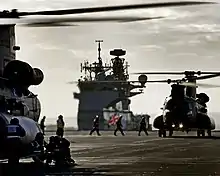
For years the U.S. Navy has been operating different versions of the single-rotor CH-53 helicopter as its heavy-lift helicopter. CH-47s regularly conduct ship-based operations for U.S. Special Forces and other international operators.[119] Due to budget issues, technical problems and delays with CH-53K, the director of the Pentagon's cost assessment office directed US Navy to consider maritime versions of CH-47. Naval versions must be protected against the corrosive seaborne environment and be able to operate from aircraft carriers and amphibious ships.[120][121]
Other export models

- The Royal Air Force version of the CH-47C is designated Chinook HC1; its versions of the CH-47D are designated Chinook HC2 and HC2A.
- The export version of the CH-47C Chinook for the Italian Army was designated "CH-47C Plus".
- The HH-47D is a search and rescue version for the Republic of Korea Air Force.
- The CH-47DG is an upgraded version of the CH-47C for Greece.
- While the CH-47SD (also known as the "Super D") is a modified variant for Singapore of the CH-47D, with extended range fuel tanks and higher payload carrying capacity; the CH-47SD is in use by the Republic of Singapore Air Force, Hellenic Army and the Republic of China Army.
- Eight CH-47Cs were delivered to the Canadian Forces in 1974. These helicopters were in Canadian service until 1991, with the designation CH-147. These aircraft were subsequently sold to the Netherlands and operated by the Royal Netherlands Air Force as CH-47Ds. All aircraft were phased out in 2021 and replaced by CH-47Fs.[122]
Civilian models
- Model 234LR (long range): Commercial transport helicopter. The Model 234LR can be fitted out as an all-passenger, all-cargo, or cargo/passenger transport helicopter.[123]
- Model 234ER (extended range): Commercial transport version.
- Model MLR (multi-purpose long range): Commercial transport version.
- Model 234UT (utility transport): Utility transport helicopter.[123]
- Model 414: The Model 414 is the international export version of the CH-47D. It is also known as the CH-47D International Chinook.
- CU-47: Built by Unical from parts from ex-Canadian Forces CH-47D/CH-147D for Coulson Aviation to be used for aerial firefighting.[124] One delivered in 2020 with 11 others to be delivered.
Derivatives
In 1969, work on the experimental BV-347 was begun. It was a CH-47A with a lengthened fuselage, four-blade rotors, detachable wings mounted on top of the fuselage and other changes. It first flew on 27 May 1970 and was evaluated for a few years.[125]
In 1973, the Army contracted with Boeing to design a "Heavy Lift Helicopter" (HLH), designated XCH-62A. It appeared to be a scaled-up CH-47 without a conventional body, in a configuration similar to the S-64 Skycrane (CH-54 Tarhe), but the project was canceled in 1975. The program was restarted for test flights in the 1980s and was again not funded by Congress.[125] The scaled-up model of the HLH was scrapped in late 2005 at Fort Rucker, Alabama.[126]
Operators

_at_the_National_Day_celebration_ceremony_2021-10-10.jpg.webp)
- German Air Force Pending an order contract[102]
_helicopters_in_Indian_Air_Force.jpg.webp)
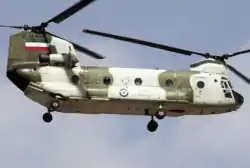
- Japan Air Self-Defense Force[127] operates 15 CH-47Js as of March 2022.[135]
- Japan Ground Self-Defense Force[127] operates 47 CH-47J/JAs as of March 2022.[135]
.jpg.webp)
.jpg.webp)
![]() Kurdistan (borrowed from Italy)[143]
Kurdistan (borrowed from Italy)[143]
- Peshmerga Air Support Command
Former operators
- Argentina
- Australia
- Royal Australian Air Force[146] (later transferred to the Australian Army)
- South Vietnam
- Thailand
- United Kingdom
- United States
.jpg.webp)
- Vietnam
Accidents
- On 4 May 1966, a CH-47A crashed near Di Linh, Lâm Đồng Province killing all 20 on board.[152]
- On 26 December 1967, a CH-47A carrying 33 military passengers and crew crashed in a landing descent at Phu Cat AFB, Binh Dinh Province, South Vietnam killing 8 of those on board.[153]
- On 6 May 1969 a CH-47 carrying 83 people crashed 3 miles (4.8 km) southwest of Phước Vĩnh Base Camp, South Vietnam, killing 40 of those on board.[154]
- On 18 August 1971, CH-47A, airframe 66-19023, was operated by the 4th Aviation Company, 15th Aviation Group. The helicopter was transporting 33 soldiers of the Heavy Mortar Platoon, 2nd Battalion, 4th Infantry Regiment, 56th Field Artillery Brigade from battalion headquarters in Ludwigsburg to Grafenwöhr for live fire training exercises. Fatigue failure of the rear rotor blade led to its separation causing structural damage resulting in the crash and explosion that killed all 37 on board, including four crew members. A memorial plaque that was placed near the crash site in the forest outside Pegnitz was stolen in 2009.[155][156]
- On 28 November 1971, a CH-47C carrying five crew and 28 soldiers from the 101st Airborne Division on a flight from Da Nang to Phu Bai Combat Base, South Vietnam crashed into high ground killing all on board.[157]
- On 18 October 1974, a CH-47C, US serial 74-22058 assigned 147001 but was never marked with Canadian Forces. The aircraft was lost on its delivery flight to Canada following gear failure in main combining gear box, caused by undetected metal infraction in gear blank before machining. This failure led to drive shaft failure and loss of synchronization and resulted in five fatalities. After a lengthy litigation, it was replaced by 147009.
- On 11 September 1982 at an airshow in Mannheim, Germany, a U.S. Army Chinook (serial number 74-22292) carrying parachutists crashed, killing 46 people. The crash was later found to have been caused by an accumulation of ground walnut shell grit used for cleaning machinery, which blocked lubrication from reaching transmission bearings.[158][159] The accident resulted in the eventual discontinuation of the use of walnut grit as a cleaning agent.
- On 4 February 1985, a Royal Australian Air Force (RAAF) CH-47C (A15-001) crashed into Perseverance Dam, Toowoomba, Queensland, Australia. The Royal Air Force (RAF) exchange pilot was rescued from the submerged cockpit but later died in hospital.[160]
- On 6 November 1986, a British International Helicopters Chinook crashed on approach to Sumburgh Airport, Shetland Islands resulting in the loss of 45 lives and the withdrawal of the Chinook from crew-servicing flights in the North Sea.[161]
- On 1 March 1991, Major Marie Therese Rossi Cayton was killed when her U.S. Army Chinook helicopter crashed into an unlit microwave tower during a dust storm. She was the first American woman to fly in combat, during Desert Storm in 1991.[162]
- On 2 June 1994, an RAF CH-47 carrying 25 British MI5, police, and military intelligence experts and 4 crew, flew from Northern Ireland to Scotland for a conference crashed on the Mull of Kintyre
- On 30 October 1997, a civilian BV234UT operated by Columbia Helicopters (registration C-FHFH) engaged in logging operations crashed on Vancouver Island, Canada, killing both of the pilots. The investigation determined that the helicopter lost yaw control due to failure of flight control computer.
- On 29 May 2001, a Republic of Korea Army (ROK Army) CH-47D installing a sculpture onto Olympic Bridge in Seoul, South Korea failed to unlatch the sculpture. The helicopter's rotors struck the monument; then the fuselage hit and broke into two. One section crashed onto the bridge in flames and the other fell into the river. All three crew members on board died.[163][164]
- On 22 February 2002, a U.S. Army special forces MH-47E crashed at sea in the Philippines, killing all ten U.S. soldiers on board.[165]
- On 11 September 2004, a Hellenic Army Aviation CH-47SD crashed into the sea off Mount Athos. All 17 people on board were killed, including four senior figures in the Greek Orthodox Church of Alexandria.[166]
- On 6 April 2005, the U.S. Army CH-47D known as "Big Windy 25" crashed during a sandstorm near Ghazni, Afghanistan, killing all eighteen aboard (fifteen soldiers and three contractors).[167] The pilots had been disoriented by the dust storm.[168]
- On 7 January 2013, a BV-234 N241CH owned by Columbia Helicopters, crashed shortly after taking off from the airport in Pucallpa, Coronel Portillo Province, Peru. All seven crew members were killed.[169]
- On 20 June 2023, a Royal Canadian Air Force CH-147F crashed in the Ottawa River near CFB Petawawa. The helicopter belonged to the 450 Tactical Helicopter Squadron. Two crew members died while the other two were hospitalized with non-life-threatening injuries.[170]
Aircraft on display
Argentina
- H-91 - CH-47C on display at the Museo Nacional de Aeronáutica de Argentina in Morón, Buenos Aires.[171]
Australia
- A15-104 - CH-47D on display at the Australian Army Flying Museum in Oakey, Queensland.[172]
Canada
- 147201 - CH-47D on display at the National Air Force Museum of Canada in Trenton, Ontario.[173]
- 147206 - CH-47D preserved as a gate guardian at CFB Petawawa.[174]
United Kingdom
- 83-24104 - Former US Army CH-47D forward section on display at Royal Air Force Museum London, modified to represent "Bravo November".[176]
United States
- 59-4984 - YCH-47B on display at the U.S. Army Transportation Museum in Fort Eustis, Virginia.[177]
- 60-3451 - CH-47A on display at the United States Army Aviation Museum in Fort Novosel, Alabama.[178]
- 61-2408 - CH-47A on display in a park across the street from the Don F. Pratt Memorial Museum in Fort Campbell, Kentucky.[179]
- 64-13149 - ACH-47A on display at the Redstone Arsenal in Alabama.[180]
- 65-7992 - Model 347 on display at the United States Army Aviation Museum in Fort Rucker, Alabama.[181]
- 85-24346 - CH-47D on display at the Combat Air Museum on Topeka Regional Airport (Forbes Field) in Topeka, Kansas.[182]
- 89-00153 - CH-47D on display at Castle Air Museum in Atwater, California.[183]
- 90-00222 - CH-47D on display outside at Fort Knox, Kentucky.[184]
Vietnam
- 65-8025 - CH-47A on display at the Khe Sanh Combat Museum.[185]
- 66-0086 - CH-47A on display at the War Remnants Museum in Ho Chi Minh City (Saigon).[186]
- 66-19082 - CH-47A on display at the Vietnam Military History Museum in Hanoi.[187]
Specifications (CH-47F)

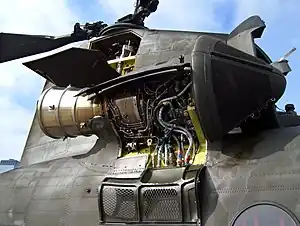
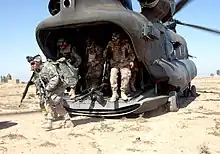
Data from Boeing CH-47D/F,[188] Army Chinook file,[189] International Directory[190]
General characteristics
- Crew: 3 (pilot, copilot, flight engineer or loadmaster)
- Capacity:
- 33–55 troops or
- 24 stretchers and 3 attendants or
- 24,000 lb (10,886 kg) payload
- Length: 98 ft (30 m) [191]
- Fuselage length: 52 ft (16 m)
- Width: 12 ft 5 in (3.78 m) (fuselage)[191]
- Height: 18 ft 11 in (5.77 m)
- Empty weight: 24,578 lb (11,148 kg)
- Max takeoff weight: 50,000 lb (22,680 kg)
- Powerplant: 2 × Lycoming T55-GA-714A turboshaft engines, 4,733 shp (3,529 kW) each
- Main rotor diameter: 2 × 60 ft (18 m)
- Main rotor area: 5,600 sq ft (520 m2)
- Blade section: root: Boeing VR-7; tip: Boeing VR-8[192]
Performance
- Maximum speed: 170 kn (196 mph, 315 km/h)
- Cruise speed: 160 kn (184 mph, 296 km/h)
- Range: 400 nmi (460 mi, 740 km)
- Combat range: 200 nmi (230 mi, 370 km)
- Ferry range: 1,216 nmi (1,399 mi, 2,252 km) [193]
- Service ceiling: 20,000 ft (6,100 m)
- Rate of climb: 1,522 ft/min (7.73 m/s)
- Disk loading: 9.5 lb/sq ft (46 kg/m2)
- Power/mass: 0.28 hp/lb (0.46 kW/kg)
Armament
- Up to 3 pintle-mounted medium machine guns (1 on loading ramp and 2 at shoulder windows), generally 7.62 mm (0.300 in) M240/FN MAG machine guns, and can be armed with the 7.62 mm M134 Minigun rotary machine gun.
Avionics
- Rockwell Collins Common Avionics Architecture System (CAAS) (MH-47G/CH-47F)
See also
Related development
Aircraft of comparable role, configuration, and era
- Mil Mi-6
- Mil Mi-26
- Sikorsky CH-53 Sea Stallion
- Sikorsky CH-54 Tarhe/Sikorsky S-64 Skycrane
- Yakovlev Yak-24
Related lists
References
- "Boeing Marks 50 Years of Delivering Chinook Helicopters". Boeing. 16 August 2012. Archived from the original on 4 March 2016.
- Leuutenant General John J. Tolson (1989). Vietnam Studies: Airmobility 1961–71. CMH Pub 90-4. Archived from the original on 12 June 2010. Retrieved 19 August 2010.
{{cite book}}:|work=ignored (help) - Apostolo, Giorgio. The Illustrated Encyclopedia of Helicopters. New York: Bonanza Books. 1984. ISBN 978-0-517-43935-7.
- Goebel, Greg. Origins: Vertol V-107 & V-114 Archived 23 June 2012 at the Wayback Machine. Vectorsite.net, 1 December 2009.
- Spenser, Jay P. Whirlybirds, A History of the U.S. Helicopter Pioneers. University of Washington Press, 1998. ISBN 0-295-97699-3.
- Holmes, Alexander (26 October 1962). "The Quiet Americans-Our Marines Overseas". Los Angeles Times. Archived from the original on 26 October 2012. Retrieved 5 July 2017.
- Warwick, Graham (1 April 2008). "Chinook: Five decades of development". Flight International. Archived from the original on 11 October 2008. Retrieved 29 March 2010.
- Lange, Katie (29 November 2019). "Why Army Helicopters Have Native American Names". Department of Defense. Retrieved 20 December 2021.
- "Chinook Information and diagrams about the transmission system". Archived from the original on 30 March 2015. Retrieved 13 November 2014.
- Belden, Tom (21 May 1982). "This Whirlybird's an early bird: Boeing Vertol's Army copter delivered on budget". The Philadelphia Inquirer. Archived from the original on 8 June 2011. Retrieved 5 April 2010.
- "Boeing Receives $1.15B Contract for 15 Canadian Chinooks, Announces Matching Reinvestment in Industry". Boeing. 10 August 2009. Archived from the original on 25 July 2011. Retrieved 11 August 2009.
- "Type Certificate Data Sheet No. H9EA" (PDF). Federal Aviation Administration. 17 January 2007. Archived from the original (.pdf) on 14 June 2007. Retrieved 8 February 2007.
- "AW1067 ICH-47F Maiden Flight" (Press release). Vergiate: Leonardo. 26 June 2013. Retrieved 20 December 2021.
- "CH-47JA Helicopter". Kawasaki. Retrieved 20 December 2021.
- "Chinook Copter to Vietnam". The New York Times. 11 August 1965. Archived from the original on 3 November 2012. Retrieved 29 March 2010.
- "Arsenal". 21 April 2017.
- Scannell-Desch, Elizabeth A.; Marion Anderson (2000). "Hardships and Personal Strategies of Vietnam War Nurses". Western Journal of Nursing Research. 22 (5): 526–550. doi:10.1177/01939450022044584. PMID 10943170. S2CID 41787367.
- Dunstan, Simon (2003). Vietnam choppers: helicopters in battle 1950–75. Osprey Publishing. p. 81. ISBN 978-0-85045-572-4.
- Anderton, David & Miller, Jay – Boeing Helicopters CH-47 Chinook. Arlington: Aerofax, Inc, 1989, p. 8. ISBN 0-942548-42-6.
- "This monster aircraft was the helicopter version of the AC-130 gunship". Business Insider.
- Marder, Murray (26 July 1973). "Oil pact with U.S. firm: Iran signs agreement". Victoria Advocate.
- Szulcs, Tad (25 July 1971). "U.S., Britain Quietly Back Military Build-Up of Iran". The New York Times. Archived from the original on 5 June 2011. Retrieved 5 April 2010.
- "US reportedly will buy copters so Iran can't". Milwaukee Journal. 22 January 1984.
- about:reader?url=http%3A%2F%2Firartesh.ir%2Fpost%2F502&tabId=4
- "Iranian troops smash four-day siege by Kurds". Lakeland Ledger. 27 August 1979.
- Sander Peeters. "Iraqi Air-to-Air Victories since 1967". Archived from the original on 19 December 2016. Retrieved 13 November 2014.
- Farrokh, Kaveh (20 December 2011). Iran at War: 1500–1988. Oxford: Osprey Publishing. ISBN 9781780962214.
- Roy, Amit (23 February 1980). "Iran feeling squeeze of European embargo". Spokesman-Review.
- "U.S. cuts off plane parts to Iran". Chicago Tribune. 9 November 1979. Archived from the original on 26 October 2012. Retrieved 5 July 2017.
- "Iran, China Seek Military Equipment From Pentagon Surplus Auctions". Fox News Channel. 16 January 2007. Archived from the original on 8 February 2010. Retrieved 19 December 2018.
- "Iranian engineers overhaul Chinook helicopter". BBC News. 27 January 2007. Archived from the original on 9 June 2011. Retrieved 5 April 2010.
- "آشنایی با هوانیروز ایران". irartesh.ir. Archived from the original on 12 February 2015. Retrieved 12 February 2015.
- Crossette, Barbara ROLE OF AMERICANS IN LIBYAN WARFARE CONFIRMED BY U.S. Published: 3 November 1981 Archived 9 January 2017 at the Wayback Machine The New York Times Retrieved 18 November 2016
- UAE awards contracts for CH-47 upgrade 15 March 2005 Archived 12 August 2017 at the Wayback Machine flightglobal.com Retrieved 18 November 2016
- "British air and land forces outnumbered". The Boston Globe. 21 May 1982. Archived from the original on 26 October 2012. Retrieved 5 July 2017.
- "MoD uses 'cut and shut' chopper". BBC News. 18 July 2009. Archived from the original on 22 July 2009. Retrieved 5 April 2010.
- "Argentine Aircraft Lost - Falklands War 1982". www.naval-history.net.
- "Boeing-Vertol CH-47C Chinook in Argentina - Fuerza Aerea Argentina". Helis.com. Retrieved 20 March 2023.
- "RAF - Royal Air Force CH47 Chinook 'Bravo November'". Royal Air Force. Archived from the original on 5 April 2011. Retrieved 5 January 2017.
- Ethell and Price 1983, pp. 147–148.
- Ethell and Price 1983, pp. 151–152.
- "The Boeing Chinook". airvectors.net. Archived from the original on 20 July 2017. Retrieved 30 April 2017.
- "CH-47D/MH-47E Chinook". Army Technology. SPG Media Limited. 2006. Archived from the original on 25 August 2006. Retrieved 27 August 2006.
- "Paras tell of their fear under fire". The Herald. 12 September 2000.
- "UK leads Nato into Kosovo". BBC News. 12 June 1999. Archived from the original on 12 August 2017. Retrieved 4 April 2010.
- Crerar, Pippa (26 January 2006). "Scots set for Taliban Hotspots". Daily Record. Archived from the original on 9 June 2011.
- "Chinook Replaces Blackhawk in Combat". Air Transportation. 5 March 2008. Archived from the original on 28 July 2009. Retrieved 4 April 2010.
- "MoD to buy 22 new Chinooks". The Daily Telegraph. London. 15 December 2009. Archived from the original on 23 February 2010. Retrieved 4 April 2018.
- Dodd, Mark (31 May 2011). "Insurgent fire may have caused fatal Chinook crash in Afghanistan". The Australian. Retrieved 31 May 2011.
- "PRESS CONFERENCE WITH CHIEF OF THE DEFENCE FORCE AIR CHIEF MARSHAL ANGUS HOUSTON AND MINISTER FOR DEFENCE STEPHEN SMITH". Department of Defence. Archived from the original on 2 June 2011. Retrieved 31 May 2011.
- "ADF Bolsters CH-47D Chinook Capability". Ministerial press release. Department of Defence. 12 December 2011. Archived from the original on 27 February 2012. Retrieved 25 December 2011.
- "Copter Downed by Taliban Fire; Elite U.S. Unit Among Dead" Archived 12 August 2017 at the Wayback Machine. The New York Times, 6 August 2011.
- "31 U.S. Troops Killed in Afghanistan Helo Crash". Defense News, 6 August 2011.
- Abraham, Suresh. "Tactical Transport Helicopters in Humanitarian Relief Operations." Archived 19 February 2014 at the Wayback Machine ADJ, April 2009.
- Edmund L. Andrews (28 August 1992). "HURRICANE ANDREW; BUSH SENDING ARMY TO FLORIDA AMID CRITICISM OF RELIEF EFFORT". The New York Times.
- Research Paper: Disaster Relief, World Vision and the Hurricane Andrew Relief Project. Published by World Vision Relief and Development, California. 1993.
- Larry Rohter (29 August 1992). "HURRICANE ANDREW-Troops Arrive With Food for Florida's Storm Victims". The New York Times.
- "Japanese military helicopters dump water on Fukushima nuclear power plant". New York Post. 16 March 2011. Archived from the original on 24 July 2013. Retrieved 17 March 2011.
- The Christian Science Monitor (17 March 2011). "CH-47 Chinook helicopter begins dumping water on nuclear reactor". The Christian Science Monitor. Archived from the original on 13 November 2014.
- McKeown, Shawne (17 March 2011). "Concern grows over spent fuel pools as crews spray nuclear plant with water". CityNews. Archived from the original on 18 March 2011.
- "Japan crisis: Radiation levels begin to dip". nzherald.co.nz. 18 March 2011.
- Pappalardo, Joe (21 March 2011). "Robot Helicopters Could Be Headed for Japan". popularmechanics.com.
- "CH-47D/F Chinook page". Boeing. Archived from the original on 4 June 2007. Retrieved 2 June 2007.
- "Boeing Signs Contract for Dutch Chinooks" (Press release). Boeing. 15 February 2007. Archived from the original on 21 June 2013. Retrieved 1 April 2015.
- Leblanc, Daniel (10 August 2009). "Chinooks will fly too late for Afghanistan". The Globe and Mail. Archived from the original on 14 August 2009. Retrieved 1 April 2015.
- "As Cuts Loom, Britain Orders 24 Chinooks From Boeing". Defense News, 15 December 2009.
- "Australia Ordering CH-47F Chinooks" Archived 3 November 2011 at the Wayback Machine. Defense Industry Daily, 22 March 2010.
- The Hon. Greg Combet AM MP (20 March 2010). "New Chinook CH-47 helicopters". Media Release. Australian Department of Defence. Archived from the original on 24 March 2010.
- "India clears purchase of 15 Chinooks and 22 Apache helicopters from US". intoday.in. Archived from the original on 28 September 2015. Retrieved 27 September 2015.
- Government of Singapore (7 November 2016). "MINDEF Signs Contracts to Acquire New Medium- and Heavy-Lift Helicopters". Archived from the original on 7 November 2016. Retrieved 7 November 2016.
- "Chinook helicopters operationalised in high-altitude locations including Siachen glacier". India Today. 21 February 2020. Retrieved 23 February 2020.
- "CH-47 Chinook - Military Aircraft". fas.org. Retrieved 19 June 2021.
- "US ARMY CH-47 Chinook Helicopter". Archived from the original on 28 October 2014. Retrieved 13 November 2014.
- Simpson, Andrew (2012). "BOEING CH-47D CHINOOK 83-24104 MUSEUM ACCESSION NUMBER X004-1310" (PDF). Royal Air Force Museum London. Archived (PDF) from the original on 9 October 2022. Retrieved 20 December 2021.
- Wayne Mutza, Helicopter Gunships: Deadly Combat Weapon Systems (Specialty Press, 2010) p52
- "ACH-47A Guns-a-go-go". United States Army Aviation Museum. 8 November 2016. Retrieved 20 December 2021.
- "Newsreel Footage - Ambush at Bông San". YouTube. Archived from the original on 11 December 2021.
- Guns a Go-Go Archived 14 May 2007 at the Wayback Machine. chinook-helicopter.com
- "Guns a Go-go". United States Army Aviation Museum. 8 November 2016. Retrieved 12 July 2022.
- US Army CH-47A / CH-47B / CH-47C / CH-47D / SOA Chinooks Archived 23 June 2012 at the Wayback Machine. Vectorsite.net, 1 July 2004.
- Curtis, Robert F. (30 December 2014). Surprised at Being Alive: An Accidental Helicopter Pilot in Vietnam and Beyond. Casemate. p. 58. ISBN 9781612002767.
- Boeing CH-47D model Chinook helicopters Archived 3 August 2008 at the Wayback Machine. chinook-helicopter.com
- Boeing, Netherlands MOD Mark 1st Flight of Royal Netherlands Air Force CH-47F (NL) Chinook Archived 5 October 2011 at the Wayback Machine 26 January 2011.
- Gunner, Jerry (November 2011). "Chinook at 50 - World Wokka Operators - Republic of Singapore Air Force". AirForces Monthly. 284: 88. ISSN 0955-7091.
- Equipment Procurement – Afghanistan Air Capabilities Archived 29 June 2009 at the Wayback Machine forces.gc.ca.
- Chinooks make their debut in Afghanistan Archived 31 October 2010 at the Wayback Machine canadianally.com
- Perkel, Colin (29 September 2014). "Probe of 2011 Canadian military chopper crash in Afghanistan still ongoing". Archived from the original on 24 April 2015. Retrieved 22 August 2018.
- Van Westerhoven, Leo (6 May 2014). "Canada receives first CH-147F Chinook". Dutch Free Press. Archived from the original on 22 August 2018. Retrieved 22 August 2018.
- Boeing MH-47D model Chinook helicopters Archived 17 May 2008 at the Wayback Machine. chinook-helicopter.com
- Boeing MH-47E model Chinook helicopters Archived 28 September 2008 at the Wayback Machine. chinook-helicopter.com
- Hoyle, Craig (6 June 2008). "UK starts Chinook HC3 'reversion' work, amid criticism". Flight International. Archived from the original on 14 July 2009. Retrieved 19 January 2009.
- Perry, Dominic (30 March 2017). "RAF welcomes updated Chinook HC5". Flight Global.
- "New Boeing CH-47F takes flight", Aerotech News and Review, 3 November 2006, p. 3.
- "Chinook Helicopter Begins Operational Test Flights with US Army" (Press release). Boeing. 19 February 2007. Archived from the original on 2 April 2015. Retrieved 1 April 2015.
- Holcomb, Henry. "New Look Chinook". The Philadelphia Inquirer, 17 August 2007. archive link
- "Boeing Awarded US Army Contract for 191 CH-47F Chinook Helicopters" (Press release). 26 August 2008. Archived from the original on 2 April 2015. Retrieved 1 April 2015.
- "Chinook ICH-47F." AgustaWestland, Retrieved 4 July 2013. Archived 6 November 2014 at the Wayback Machine
- Warwick, Graham (22 April 2013). "Block 2 CH-47F to Tackle Payload Shortfalls". Aviation Week's Defense Technology International edition. Archived from the original on 23 July 2015. Retrieved 1 April 2015 – via Military.com. (Original story Archived 3 April 2015 at the Wayback Machine Aviation Week )
- Trimble, Stephen (31 March 2015). "US Army outlines CH-47F upgrades for 100-year lifespan". Flightglobal.com. Archived from the original on 2 April 2015. Retrieved 31 March 2015.
- Judson, Jen (5 April 2022). "US Army shelves advanced CH-47F rotor blades due to issues in testing". Defense News. Retrieved 19 April 2022.
- "Breaking: Germany makes its choice for Boeing's CH-47 Chinook official". aviacionline.com. 1 June 2022. Retrieved 19 June 2022.
- "Germany – CH-47F Chinook Helicopters | Defense Security Cooperation Agency". www.dsca.mil. Retrieved 13 May 2023.
- Warwick, Graham (1 April 2008). "Chinook: CAAS unites rotorcraft cockpits". Archived 4 April 2008 at the Wayback Machine. Flight International.
- "MH-47E/G Special Operations Chinook product page". Archived 21 December 2012 at the Wayback Machine. Boeing.
- "Superfast Helicopters". Archived 31 March 2013 at the Wayback Machine. Defensemedianetwork.com, 25 October 2011.
- Donald, David (2 September 2020). "First Block II Chinook for Special Operations Command". AIN Online. Retrieved 8 July 2021.
- Haxell, Helen (12 September 2017). "DSEI 2017: Chinook to stay in UK's future fleet". Shephard Media. Archived from the original on 16 September 2017. Retrieved 15 September 2017.
- "United Kingdom – H-47 Chinook (Extended Range) Helicopters and Accessories" (Press release). DSCA. Archived from the original on 20 October 2018. Retrieved 20 October 2018.
- Kawasaki Heavy Industries CH-47J Archived 18 November 2016 at the Wayback Machine helis.com Retrieved 18 November 2016
- Crawford, Steve (2003). Twenty-first century military helicopters: today's fighting gunships. Zenith Imprint. p. 48. ISBN 978-0-7603-1504-0.
- goebel, greg. "Chinook in commercial & foreign service". Vectorsite.net. Archived from the original on 27 December 2010. Retrieved 9 March 2011.
- McGinley, Donna. "Boeing Core Business Activities" (PDF). Advocacy and Public Policymaking. Archived from the original (PDF) on 12 June 2011. Retrieved 9 March 2011.
- "Flight International. Number 4006. Volume 129. New-build CH-47D ready for co-production. p.11". Flight International. 12 April 1986. Archived from the original on 4 November 2012. Retrieved 9 March 2011.
- Jackson, Paul (22 July 1999). "Jane's All the World's Aircraft 1999-00. THE BOEING COMPANY. BOEING 114 and 414. US ARMY MH-47E PROCUREMENT". Retrieved 9 March 2011.
- "Boeing: Boeing Awarded U.S. Air Force Combat Search and Rescue Contract". Archived from the original on 14 May 2013. Retrieved 6 February 2016. Boeing News Release
- "Bowing To GAO, USAF Likely To Recompete CSAR-X" Archived 7 March 2012 at the Wayback Machine. Aviation Week, 28 February 2007.
- Trimble, Stephen. "USAF abandons large helicopter for rescue mission, proposes buying 112 UH-60Ms" Archived 27 February 2011 at the Wayback Machine. Flight International. 24 February 2010.
- USAF HH-60 Personnel Recovery Recapitalization Program Sources Sought RFI Archived 21 July 2011 at the Wayback Machine. FBO.gov, 23 March 2010.
- "Why the Navy may look to this Army workhorse for special ops". 29 April 2020.
- Trail, Scott (3 February 2020). "Replacing US Marine's CH-53K helos with CH-47F choppers is a poor idea". Defense News.
- "Pentagon Review Pits Boeing vs. Lockheed for Marine Helicopters". Bloomberg.com. 6 May 2019.
- Jennings, Gareth (23 December 2021). "Netherlands retires CH-47D Chinooks". Jane's. Retrieved 24 December 2021.
- "Model 234 Chinook". Boeing.com. Retrieved 20 December 2021.
- "Coulson's CU-47 is ready for the fire fight".
- Goebel, Greg. "ACH-47A Gunship / Model 347 / XCH-62 HLH (Model 301) / Model 360" Archived 26 June 2010 at the Wayback Machine. Vectorsite.net, 1 December 2009.
- "XCH-62 with photo". Archived from the original on 13 November 2014. Retrieved 13 November 2014.
- "World Air Forces 2014" (PDF). Flightglobal Insight. 2014. Archived (PDF) from the original on 9 October 2022. Retrieved 14 February 2014.
- "National Airborne Service Corps (NASC)". taiwanairpower.org. Retrieved 12 February 2013.
- Jennings, Gareth (2 May 2017). "US approves additional CH-47Ds for Greece". IHS Jane's 360. Archived from the original on 3 May 2017. Retrieved 3 May 2017.
- "Boeing bags $1bn IAF chopper deal". indiatimes.com. 30 October 1012. Retrieved 12 February 2013.
- "Boeing delivers first four Chinook helicopters for IAF - Times of India". The Times of India. Retrieved 10 February 2019.
- "Indian Air Force gets 15 deadly and heavyweight Chinook Helicopters! To help operations in the Northeast Region". 27 May 2020. Archived from the original on 8 March 2022. Retrieved 4 April 2022.
- "BNPB Datangkan Chinook dan Black Hawk Untuk Tangani Karhutla". bpbnnews.id (in Indonesian). 20 August 2020. Archived from the original on 26 November 2020. Retrieved 11 December 2020.
- "BNPB Datangkan 2 Helikopter Buatan AS untuk Tangani Bencana". inews.id (in Indonesian). 18 August 2020. Retrieved 11 December 2020.
- Defence of Japan 2022 (Annual White Paper). p.53. Japan Ministry of Defence
- "Boeing Vertol CH-47 Chinook". Demand media. Retrieved 29 December 2012.
- Jennings, Gareth (2 May 2017). "Netherlands signs for two more Chinooks". IHS Jane's 360. Archived from the original on 3 May 2017. Retrieved 3 May 2017.
- "Boeing Adds $26M To Saudi CH-47F Sales Contract". rotorandwing.com. 29 May 2018. Archived from the original on 20 August 2018. Retrieved 4 August 2018.
- Waldron, Greg (4 January 2019). "Boeing to upgrade Spain CH-47D fleet to -F standard". Flight Global. Singapore. Archived from the original on 4 January 2019. Retrieved 4 January 2019.
- "Boeing Vertol CH-47 Chinook". Demand media. Retrieved 12 December 2012.
- GDC (4 July 2021). "Boeing To Deliver 14 Extended-range Chinook Helicopters To Royal Air Force". Global Defense Corp. Retrieved 30 July 2021.
- "Boeing CH-47D/F". Boeing.com. Archived from the original on 10 October 2012. Retrieved 12 February 2013.
- www.rudaw.net https://www.rudaw.net/english/kurdistan/110220154. Retrieved 27 October 2023.
{{cite web}}: Missing or empty|title=(help) - "Fuerza Aerea Argentina CH-47C". Retrieved 31 July 2014.
- "Comando de Aviacion de Ejercito Argentino CH-47C". Retrieved 12 February 2013.
- "Royal Australian Air Force CH-47C". Retrieved 12 February 2013.
- "World Air Forces 1971 pg 940". flightglobal.com. Retrieved 14 February 2014.
- "40th Years Retrospective: The Helicopter Industry's [Heyday]". aviationtoday.com. Archived from the original on 25 October 2016. Retrieved 13 February 2013.
- "British Airways Helicopters Boeing 234L". Retrieved 12 February 2013.
- "SP-3300 Flight Research at Ames, 1940-1997". nasa.gov. Retrieved 12 February 2013.
- "World Air Forces 1987 pg 105". flightglobal.com. Retrieved 14 February 2014.
- "Boeing CH-47A Chinook 64-13138, o4 May 1966". Aviation Safety Network. Retrieved 19 February 2021.
- "Boeing CH-47A Chinook helicopter 66-19006".
- "Headquarters MACV Monthly Summary May 1969" (PDF). Headquarters United States Military Assistance Command, Vietnam. 1 October 1969. p. 18. Retrieved 25 February 2020.
 This article incorporates text from this source, which is in the public domain.
This article incorporates text from this source, which is in the public domain. - "37 GIs Die as Copter Falls in Germany". Chicago Tribune. 19 August 1971. Archived from the original on 24 September 2015. Retrieved 30 June 2017.
- "Tafel an Hubschrauber-Gedenkstätte verschwunden" [Disappeared Plaque on Helicopter Memorial]. Nordbayern online (in German). 14 August 2009. Archived from the original on 20 August 2017. Retrieved 30 June 2017.
- "Accident Boeing CH-47C Chinook 68-15866". Aviation Safety Network. Retrieved 16 November 2020.
- Air show safety in the spotlight Archived 1 July 2004 at the Wayback Machine, BBC, 27 July 2002.
- "Ursula J. Schoenborn v. The Boeing Company, 769 F.2d 115 (3d Cir. 1985) – a case in the US Court of Appeals for the Third Circuit". resource.org. Archived from the original on 1 December 2008. Retrieved 30 April 2017.
- "RAAF Museum: Royal Australian Air Force". airforce.gov.au. Department of Defence. Archived from the original on 1 April 2017. Retrieved 30 April 2017.
- Report No: 2/1988. Report on the accident to Boeing Vertol (BV) 234 LR, G-BWFC 2.5 miles east of Sumburgh, Shetland Isles, 6 November 1986 Archived 16 July 2012 at archive.today
- "Marie Therese Rossi Cayton". Arlington National Cemetery site. Archived from the original on 2 May 2009. Retrieved 21 June 2009.
- "S. Korean Helicopter Crashes into Bridge, 3 Killed". People's Daily, 30 May 2001. Archived from the original on 24 November 2009.
- "Crew killed as Korean helicopter hits sculpture" Archived 22 February 2018 at the Wayback Machine. The Daily Telegraph, 30 May 2001.
- A Crash in Philippines Archived 25 May 2012 at the Wayback Machine. chinook-helicopter.com,
- Bamber, David. "Four Orthodox church leaders die in air crash". Archived 7 November 2018 at the Wayback Machine The Daily Telegraph, 12 September 2004.
- "Washington man presumed dead in Afghanistan crash". The Seattle Times. Associated Press. 10 April 2005. Archived from the original on 7 November 2018. Retrieved 26 July 2017.
- Kakesako, Gregg K. (29 July 2005). "Helicopter crash caused by dust storm, Army says". Honolulu Star-Bulletin. Archived from the original on 8 August 2010. Retrieved 26 July 2017.
- "Portland-area native among 7 killed in Peru helicopter crash" Archived 22 February 2014 at the Wayback Machine. The Oregonian, 8 January 2013.
- "2 missing helicopter crew members found dead". Canadian Broadcasting Corporation. 21 June 2023. Retrieved 22 June 2022.
- "s/n H-91 FAA". AerialVisuals. Retrieved 26 July 2019.
- "c/n M.3453". helis.com. Retrieved 27 July 2019.
- "Chinook". National Air Force Museum of Canada. Archived from the original on 25 December 2019. Retrieved 26 July 2019.
- "Canadian CH-147D Chinooks to Museums". helis.com. Retrieved 27 July 2019.
- "MM80840". JetPhotos. Retrieved 27 July 2019.
- "Boeing CH47D Chinook (Forward fuselage section)". Royal Air Force Museum. Retrieved 27 July 2019.
- "59-04984". chinook-helicopter.com. Retrieved 26 July 2019.
- "Rotary Wing". United States Army Aviation Museum. 29 October 2016. Archived from the original on 1 August 2019. Retrieved 26 July 2019.
- "Fort Campbell". EuroDemobbed. Retrieved 26 July 2019.
- "Redstone Arsenal". USDemobbed. Retrieved 27 July 2019.
- "65-7992". Airliners. Retrieved 26 July 2019.
- "Boeing CH-47D Chinook". www.combatairmuseum.org. Retrieved 4 June 2021.
- "Our Collection". Castle Air Museum. Retrieved 27 July 2019.
- "Fort Knox - Goodman AAF". US Demobbed. Retrieved 27 July 2019.
- "65-8025". helis.com. Retrieved 26 July 2019.
- "War Remnants Museum". aviationmuseum.eu. 19 November 2016. Retrieved 26 July 2019.
- "66-19082". Airliners. Retrieved 26 July 2019.
- "CH-47 Technical Specifications". Boeing. Archived from the original on 13 March 2016. Retrieved 19 March 2016.
- "CH-47 CHINOOK HELICOPTER". army.mil. 4 November 2014. Archived from the original on 29 March 2016. Retrieved 19 March 2016.
- Frawley, Gerard: The International Directory of Military Aircraft, p. 49. Aerospace Publications Pty Ltd, 2002. ISBN 1-875671-55-2.
- "Boeing: H-47 Chinook". www.boeing.com. Archived from the original on 13 March 2016. Retrieved 19 March 2016.
- Lednicer, David. "The Incomplete Guide to Airfoil Usage". m-selig.ae.illinois.edu. Retrieved 16 April 2019.
- United States of America. Naval Training Equipment Center. Department of the Navy. Recognition Study Cards – US and Foreign Aircraft. Device 5E14H. LSN 6910-LL-C006462. Orlando, Florida. 1982. 55 Cards. Annotation: 2252 kilometers.
External links
- Official website

- MH-47E/G, CH-47 history, and Model 234 Chinook history pages on Boeing.com
- CH-47A/B/C, ACH-47A, CH-47D/F and CH-47 Chinook pages on Army.mil
- CH-47 page on Vectorsite.net
- "Boeing's New Combat-Ready CH-47F Chinook Helicopter Fielded to First US Army Unit"
- Italian Chinooks – CASR Article
- The Kopp-Etchells Effect – CH-47 Night Landings in Afghanistan Archived 20 August 2009 at the Wayback Machine. Michael Yon online magazine
- The short film STAFF FILM REPORT 66-2A (1966) is available for free viewing and download at the Internet Archive.
.jpg.webp)
